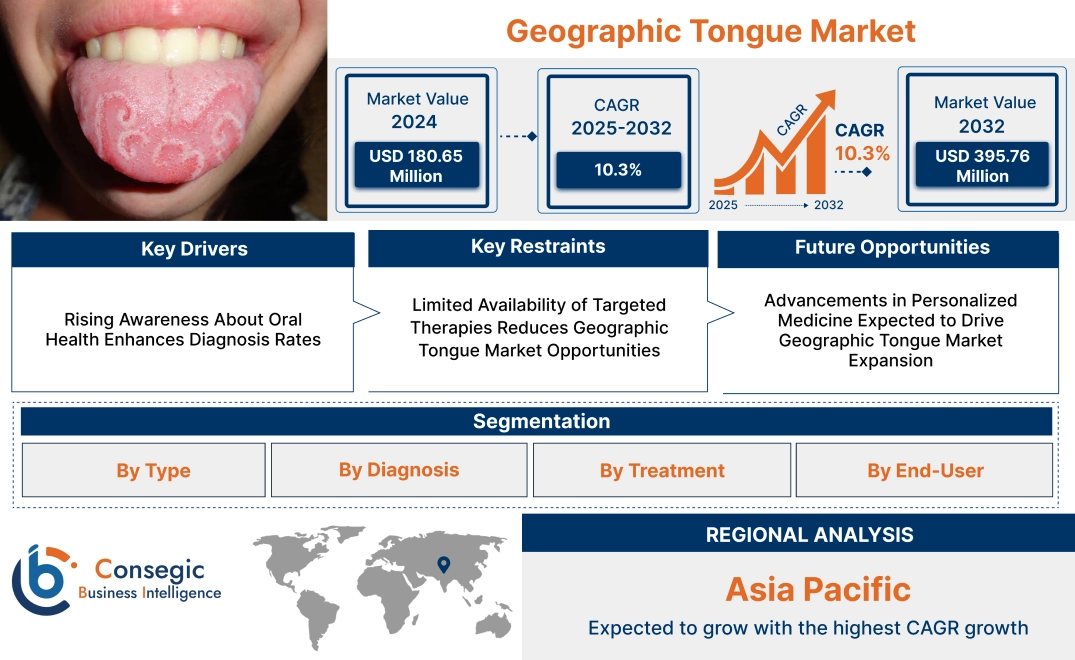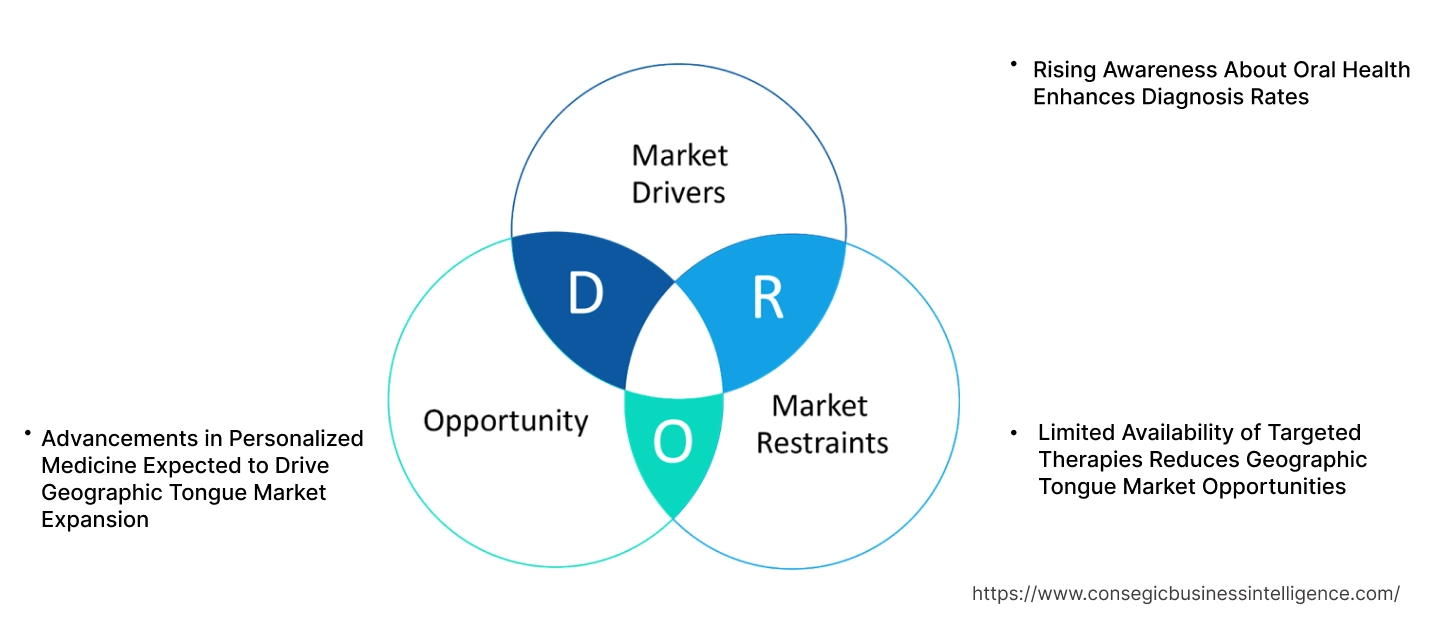- Summary
- Table Of Content
- Methodology
Geographic Tongue Market Size:
Geographic Tongue Market size is estimated to reach over USD 395.76 Million by 2032 from a value of USD 180.65 Million in 2024 and is projected to grow by USD 196.04 Million in 2025, growing at a CAGR of 10.3% from 2025 to 2032.
Geographic Tongue Market Scope & Overview:
Geographic tongue, also known as benign migratory glossitis, is a non-contagious inflammatory condition affecting the tongue’s surface. It is characterized by irregular, smooth, red patches surrounded by white or light-colored borders. The patches may change size, shape, or location over time. Key features include the appearance of lesion-like patterns on the tongue, with symptoms ranging from discomfort to sensitivity to certain foods. The condition is generally harmless and does not cause long-term damage.
The benefits of addressing geographic tongue include improved patient comfort, better dietary management, and enhanced oral health awareness. Treatments and management options focus on alleviating discomfort and identifying potential underlying causes. Applications of geographic tongue diagnosis and management include medical research, dental practices, and clinical care settings. End-use industries involve healthcare providers, pharmaceutical companies, and academic institutions working on oral health conditions.
Key Drivers:
Rising Awareness About Oral Health Enhances Diagnosis Rates
Increased awareness about oral health has led to higher diagnosis rates of conditions like geographic tongue. Healthcare campaigns and initiatives educate individuals about recognizing symptoms such as tongue discoloration, burning sensations, or lesions. Diagnostic tools in dental clinics and general healthcare settings facilitate early detection and management of geographic tongue. For instance, community health programs focus on improving oral hygiene practices, encouraging individuals to seek professional advice for abnormalities. Thus, growing awareness about oral health has significantly contributed to the geographic tongue market demand for diagnostic and treatment solutions.
Key Restraints:
Limited Availability of Targeted Therapies Reduces Geographic Tongue Market Opportunities
The absence of specific and targeted treatments for geographic tongue limits the effectiveness of current management approaches. Most treatments involve symptomatic relief through topical medications or dietary modifications, which may not fully address the condition. For example, corticosteroids and antihistamines are prescribed to manage inflammation or discomfort, but their efficacy varies among patients.
This lack of targeted therapies restricts the geographic tongue market growth by diminishing patient confidence in available solutions.
Future Opportunities :
Advancements in Personalized Medicine Expected to Drive Geographic Tongue Market Expansion
The adoption of personalized medicine in dermatology and oral health is projected to create significant geographic tongue market opportunities. Future developments may involve genetic profiling to identify predispositions, allowing tailored treatment plans for individual patients. For instance, advancements in biomarker research could lead to targeted therapies addressing the underlying causes of geographic tongue.
Therefore, the integration of personalized medicine into the diagnosis and treatment of geographic tongue is anticipated to enhance geographic tongue market growth and patient outcomes in the coming years.
Geographic Tongue Market Segmental Analysis :
By Type:
Based on type, the geographic tongue market is segmented into benign migratory glossitis and erythema migrans.
The benign migratory glossitis sector accounted for the largest revenue in geographic tongue share in 2023.
- Benign migratory glossitis, also known as geographic tongue, is a condition characterized by irregular, red patches on the surface of the tongue, surrounded by a white or light-colored border.
- This condition is considered harmless and is often asymptomatic, though it can cause discomfort or sensitivity in some individuals.
- The condition is typically diagnosed through clinical examination, and it affects a significant portion of the population, contributing to its high revenue share.
- Growing awareness of the condition, coupled with the availability of over-the-counter treatments, is expected to drive the revenue in this segment.
- The benign migratory glossitis sector is expected to continue leading the market due to its widespread prevalence and the relatively simple management of the condition.
- Therefore, according to geographic tongue market analysis, the benign migratory glossitis segment remains the dominant revenue contributor, driven by its higher prevalence and manageable nature.
The erythema migrans sector is anticipated to register the fastest CAGR during the forecast period.
- Erythema migrans, a form of geographic tongue, presents with red, inflamed patches and is often linked to systemic conditions.
- This condition can cause more significant discomfort compared to benign migratory glossitis, requiring more extensive treatment, which may involve corticosteroids or other topical medications.
- As the awareness of this form of geographic tongue grows, more individuals are seeking medical attention, contributing to its rapid trend rate.
- Increased focus on patient education and advancements in treatment options are expected to boost the trend for therapies and drive the trend of this segment.
- Thus, according to geographic tongue market analysis, erythema migrans is expected to witness rapid trend due to its more severe symptoms, increasing awareness, and the need for advanced treatments.
By Diagnosis:
Based on diagnosis, the geographic tongue market is segmented into clinical examination, biopsy, and blood tests.
The clinical examination sector accounted for the largest revenue of 71.34% in geographic tongue share in 2023.
- Clinical examination remains the most common and straightforward method for diagnosing geographic tongue.
- Healthcare professionals typically rely on visual inspection of the tongue to identify the characteristic lesions, making this approach the first-line diagnostic tool.
- With the growing number of diagnosed cases, the geographic tongue trend for clinical diagnosis remains strong.
- This non-invasive method of diagnosis is convenient and widely accessible, further contributing to the revenue share of this segment.
- Therefore, according to market analysis, the clinical examination sector is the leading method for diagnosing geographic tongue, owing to its simplicity, accessibility, and effectiveness in identifying the condition.
The biopsy sector is anticipated to register the fastest CAGR during the forecast period.
- A biopsy is used in cases where the diagnosis is uncertain or when lesions resemble other conditions that may require confirmation.
- As healthcare awareness increases, individuals are opting for more thorough diagnostic procedures, including biopsies.
- The increasing adoption of advanced diagnostic methods is expected to spur the growth of this segment.
- Thus, according to market analysis, the biopsy sector is expected to grow rapidly as healthcare providers increasingly rely on advanced diagnostic techniques to confirm or rule out conditions.
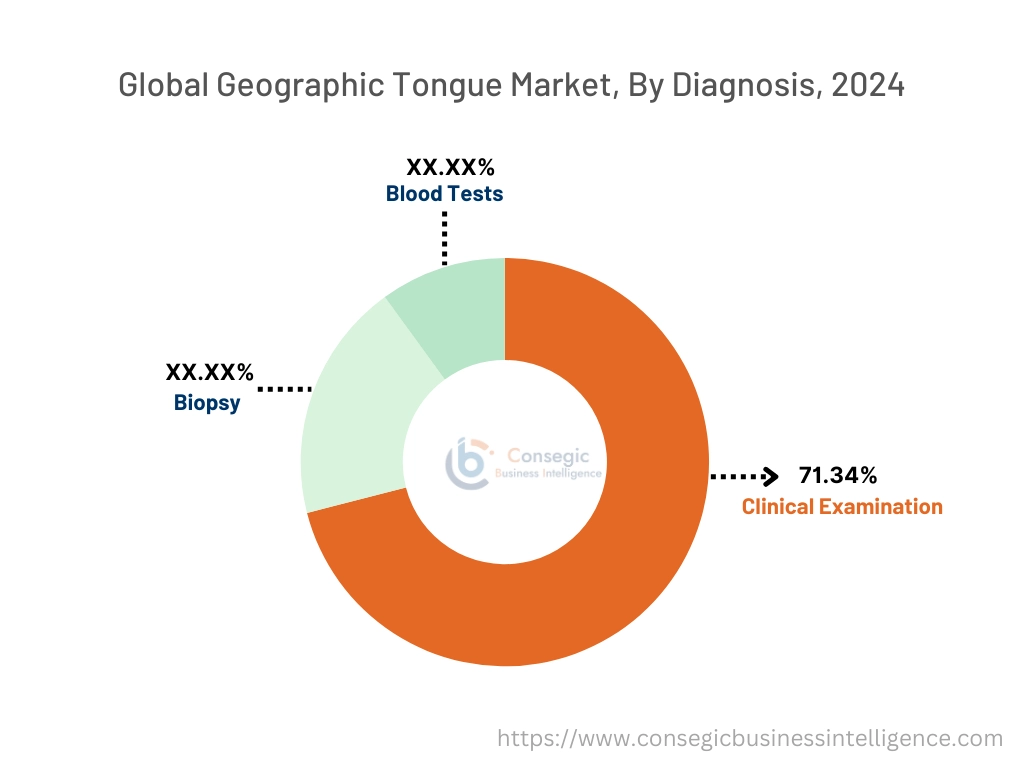
By Treatment:
Based on treatment, the geographic tongue market is segmented into pain relievers, topical corticosteroids, antihistamines, and vitamin and mineral supplements.
The pain relievers sector accounted for the largest revenue share in 2023.
- Pain relievers, including over-the-counter options like ibuprofen and acetaminophen, are commonly used to alleviate discomfort caused by geographic tongue lesions.
- These treatments are readily available and are the first choice for many individuals managing mild symptoms of the condition.
- The wide availability of pain relievers without prescription and their effectiveness in symptom management contributes to the high revenue share of this segment.
- Therefore, according to market analysis, pain relievers are expected to continue to dominate the market due to their accessibility and effectiveness in managing symptoms.
The topical corticosteroids sector is anticipated to register the fastest CAGR during the forecast period.
- Topical corticosteroids are used to reduce inflammation and provide relief from pain and irritation caused by geographic tongue lesions.
- This treatment is often prescribed when symptoms are more severe or when over-the-counter pain relievers are insufficient.
- As healthcare providers increasingly recommend corticosteroid-based treatments for their effectiveness in managing more severe cases, this segment is expected to grow at a rapid pace.
- Thus, according to market analysis, the topical corticosteroids segment is likely to register the fastest trend, driven by their effectiveness in treating more severe cases and growing healthcare provider recommendations.
By End-User:
Based on end-users, the geographic tongue market is segmented into hospitals, dental clinics, and ambulatory care centers.
The hospital sector accounted for the largest revenue share in 2023.
- Hospitals are often the first point of contact for individuals seeking medical attention for more severe or symptomatic cases of geographic tongue.
- These facilities are equipped with specialized diagnostic tools and treatments, making them essential for managing more complex cases.
- With a higher volume of patients and advanced treatment options, hospitals continue to contribute significantly to the revenue in this market.
- Therefore, according to market analysis, hospitals maintain their dominant position in the market due to their comprehensive care capabilities and advanced treatment options.
The ambulatory care centers sector is anticipated to register the fastest CAGR during the forecast period.
- Ambulatory care centers provide outpatient services, offering a convenient and cost-effective alternative to hospital visits.
- As the healthcare landscape evolves, individuals with milder symptoms are increasingly seeking treatment in these settings.
- The rise of telemedicine and outpatient consultations has further fueled the trend for ambulatory care, contributing to the geographic tongue trend of this sector.
- Thus, according to market analysis, ambulatory care centers are set to experience rapid growth, driven by the growing preference for outpatient care and cost-effective treatment options.
Regional Analysis:
The regional segment includes North America, Europe, Asia Pacific, Middle East and Africa, and Latin America.
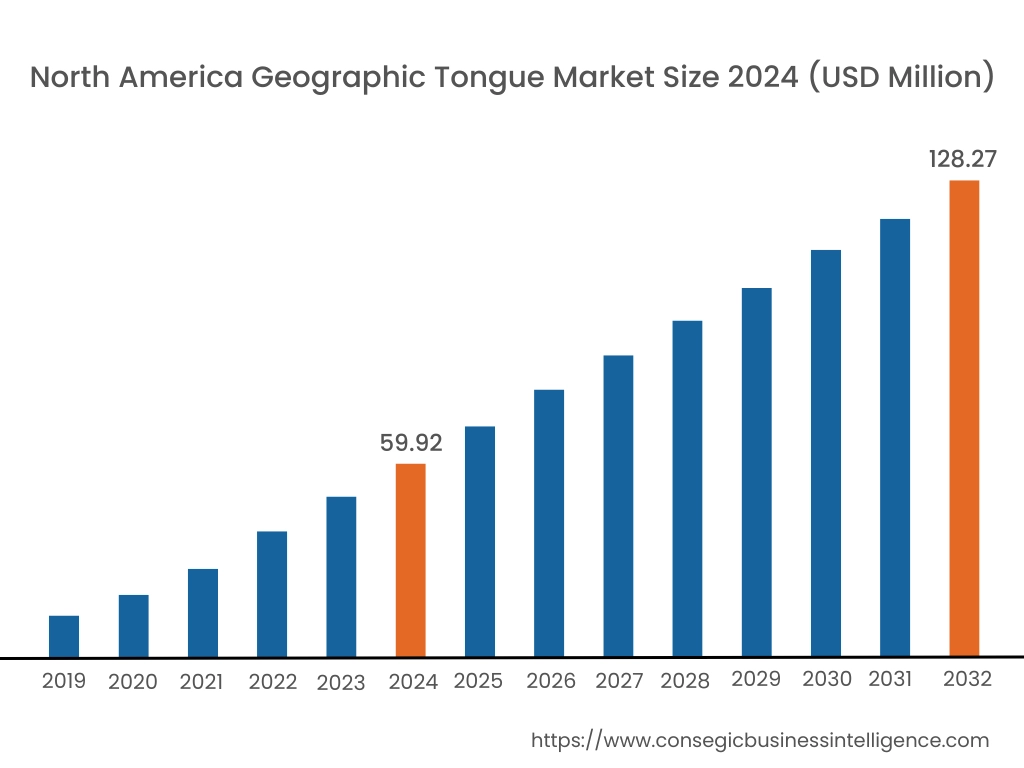
In 2024, North America was valued at USD 59.92 Million and is expected to reach USD 128.27 Million in 2032. In North America, the U.S. accounted for the highest share of 72.80% during the base year of 2024. In North America, the geographic tongue market shows a steady demand, with the United States and Canada leading the market. The prevalence of geographic tongue, a condition that affects a significant portion of the population, contributes to the market's performance. Factors such as increasing awareness of oral health conditions, along with advances in diagnostics and treatment options, further support the market. The region's well-established healthcare infrastructure also facilitates access to treatments, including topical therapies and medications that address symptoms.
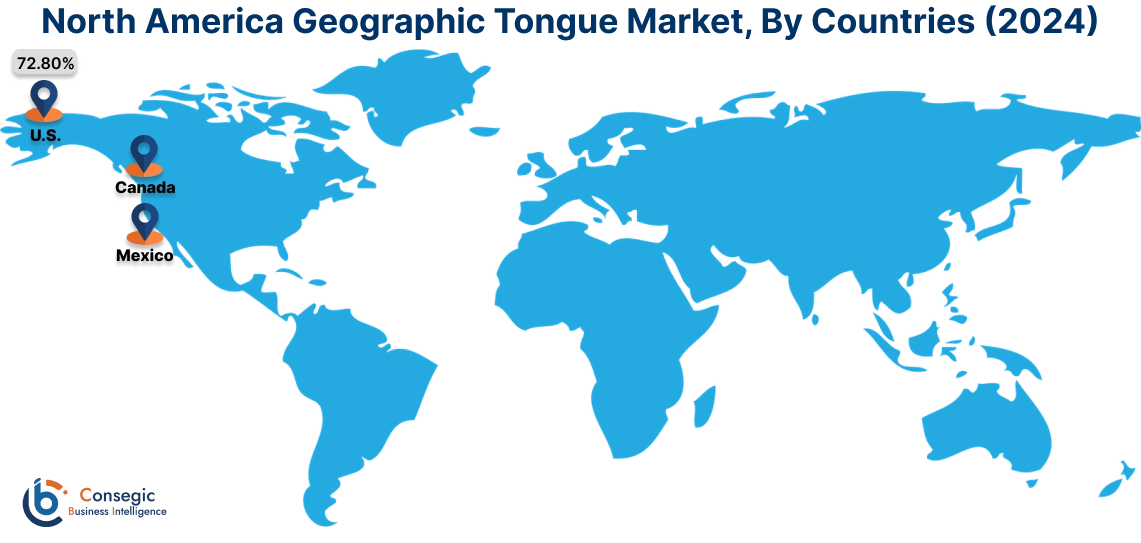
In Asia Pacific, the market is experiencing the fastest growth with a CAGR of 10.8% over the forecast period. Asia-Pacific is witnessing a gradual rise in the geographic tongue market, with countries like India, Japan, and China seeing increasing cases of the condition. The rising awareness of oral health and the improving healthcare infrastructure in these nations contribute to the market's trend. Additionally, increased access to healthcare services, coupled with a growing emphasis on early diagnosis, boosts the demand for treatments. However, challenges such as limited awareness in rural areas and varying healthcare access levels may slightly hinder market development in some regions.
In Europe, the geographic tongue market is stable, with a growing recognition of the condition in countries like Germany, the UK, and France. The increasing awareness of oral conditions and the availability of specialized treatments for geographic tongue play a significant role in market trend. The region also benefits from strong healthcare systems and the presence of key market players offering advanced therapies. Furthermore, the rising demand for non-invasive treatments and the growing focus on personalized care options are contributing to geographic tongue expansion.
The Middle East and Africa are experiencing gradual growth in the geographic tongue market. In regions like the UAE, Saudi Arabia, and South Africa, the demand for treatments is rising due to better access to healthcare facilities and growing awareness of oral health. However, the market faces challenges, such as a lack of widespread awareness in certain areas and limited healthcare access in remote regions. As healthcare infrastructure improves and education about oral health conditions increases, the market is expected to expand steadily.
Latin America’s geographic tongue market shows moderate performance, with countries like Brazil and Mexico accounting for a significant share. The rising prevalence of the condition and the increasing focus on healthcare awareness drive market growth. However, healthcare accessibility and the need for more widespread education on geographic tongue may limit geographic tongue expansion in certain areas. As awareness campaigns and healthcare infrastructure improve, the market in Latin America is poised for gradual growth, particularly in urban regions with better access to medical treatments.
Top Key Players and Market Share Insights:
The Global Geographic Tongue Market is highly competitive with major players providing FWA to the national and international markets. Key players are adopting several strategies in research and development (R&D), product innovation, and end-user launches to hold a strong position in the Global Geographic Tongue Market. Key players in the Geographic Tongue industry include-
- AbbVie Inc. (United States)
- Pfizer Inc. (United States)
- Merck & Co., Inc. (United States)
- Teva Pharmaceutical Industries Ltd. (Israel)
- Eli Lilly and Company (United States)
- Novartis International AG (Switzerland)
- Johnson & Johnson (United States)
- GSK plc (United Kingdom)
- Bayer AG (Germany)
- Mylan N.V. (United States)
Geographic Tongue Market Report Insights :
| Report Attributes | Report Details |
| Study Timeline | 2019-2032 |
| Market Size in 2032 | USD 395.76 Million |
| CAGR (2025-2032) | 10.3% |
| By Type |
|
| By Diagnosis |
|
| By Treatment |
|
| By End-Use |
|
| By Region |
|
| Key Players |
|
| North America | U.S. Canada Mexico |
| Europe | U.K. Germany France Spain Italy Russia Benelux Rest of Europe |
| APAC | China South Korea Japan India Australia ASEAN Rest of Asia-Pacific |
| Middle East and Africa | GCC Turkey South Africa Rest of MEA |
| LATAM | Brazil Argentina Chile Rest of LATAM |
| Report Coverage |
|
Key Questions Answered in the Report
How big is the Geographic Tongue Market? +
In 2024, the Geographic Tongue Market was USD 180.65 million.
What will be the potential market valuation for the Geographic Tongue Market by 2032? +
In 2032, the market size of Geographic Tongue Market is expected to reach USD 395.76 million.
What are the segments covered in the Geographic Tongue Market report? +
The type, diagnosis, treatment, and end-user are the segments covered in this report.
Who are the major players in the Geographic Tongue Market? +
AbbVie Inc. (United States), Pfizer Inc. (United States), Novartis International AG (Switzerland), Johnson & Johnson (United States), GSK plc (United Kingdom), Bayer AG (Germany), Mylan N.V. (United States), Merck & Co., Inc. (United States), Teva Pharmaceutical Industries Ltd. (Israel), Eli Lilly and Company (United States), are the major players in the Geographic Tongue market.
